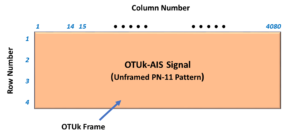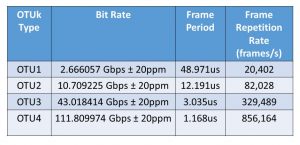What is the OTUk-AIS Maintenance Signal?
What exactly is an OTUk-AIS signal?
AIS is an acronym for Alarm Indication Signal.
Another post describes the role/function of AIS.
Whenever an OTN Network Equipment (NE) transmits an OTUk-AIS signal, it generates and transmits an Unframed PN-11 (e.g., PRBS11) Pattern.
More specifically, ITU-T G.709 defines this PN-11 sequence by the generating polynomial: 1 + x9 + x11.
Since this is an Unframed signal, then this means that all of the OTUk, ODUk, and OPUk overhead fields (within the OTUk signal) will be overwritten with this PN-11 pattern.
Figure 1 presents a simple illustration of an OTUk-AIS signal.

Figure 1, Simple Illustration of an OTUk-AIS signal.
What are the timing/frequency requirements for an OTUk-AIS signal?
The OTN NE will need to transmit this signal at the same nominal bit rate as an ordinary OTUk signal.
Like any ordinary OTUk signal, the OTN STE will need to transmit this data at the nominal bit-rate ± 20ppm.
Table 1 presents the nominal bit-rates for the OTUk signals (and, in turn, for the OTUk-AIS signal) for each value of k.
Table 1, Required Bit Rates for the OTUk-AIS signal.

Does the OTN NE need to align the PN-11 pattern sequence with the OTUk frame?
In short, the answer is No.
The length of the PN-11 sequence is 2047 bits (e.g., 211 – 1). And the capacity of a given OTUk frame is 130,560 bits.
Since the numeral 130,560 is NOT an integral multiple of 2047, the PN-11 sequence will cross OTUk frame boundaries.
When would OTN Network Equipment transmit/generate an OTUk-AIS signal?
For the time being, ITU-T G.709 has not defined a set of conditions (or defects) upon which the OTN STE would transmit the OTUk-AIS signal.
ITU-T G.709 has reserved this type of signal as a placeholder for future use.
The standards committee may (at a later time) specify a set of conditions upon which an OTN STE would transmit the OTUk-AIS signal.
Additionally, ITU-T G.709 is NOT requiring that OTN Equipment or Chip Vendors design their products to be capable of generating/transmitting the OTUk-AIS signal.
However, ITU-T G.709 mandates that OTN Equipment and Chip Vendors be capable of receiving, detecting, and flagging the OTUk-AIS pattern.
Click HERE for Information on How an STE does declare and clear the dAIS (OTUk-AIS) defect condition.
Why are we even talking about an OTUk-AIS Signal if we are NOT currently required to generate it?
Once again, the Standards Committee has reserved this signal for FUTURE USE.
They envision defining conditions for which an OTN Section Terminating Equipment (STE) would generate and transmit the OTUk-AIS signal in a system application.
Is there another type of AIS signal that OTN APPLICATIONS ARE ACTIVELY USING?
Yes, ITU-T G.709 also recommends the use of ODUk-AIS. OTN Path Terminating Equipment is actively using the ODUk-AIS indicator.
Has Inflation got You Down? Our Price Discounts Can Help You Fight Inflation and Help You Become an Expert on OTN!! Click on the Banner Below to Learn More!!
Temporary Discount Offered!!
For More Information on OTN Posts in this Blog, click on the Image below.



